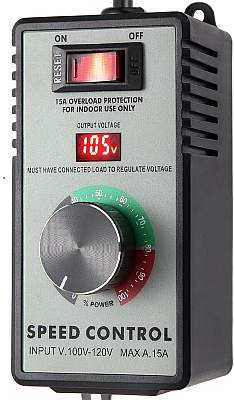Many phonon resonance experiments require a constant temperature environment. Professional lab equipment is very expensive, but there are other ways to assemble your own constant-temperature chamber. One is by combining a PID controller with a standard household appliance, like a heat plate or simple crock pot, etc.
Please see this post for more info: How to build a precision temperature controller using PID
Many standard items have too much heating power, though, and for an optimum PID setting, the power should be reasonable so that the switching time is not extreme (e.g., only turning on for 5 seconds during a minute). Switching time should be more balanced for better performance to achieve the best temperature stability.
One solution is to reduce the power of the heating element by inserting a speed controller device, which is readily available. This device allows the power output of a heating element to be reduced variably. However, this only works with heating devices that have a simple on/off switch and manual controls, not an electronic panel or internal chip.
This is what such a device looks like:

How does this speed controller work?
In simple terms, these controllers work by rapidly turning the power on and off in short intervals (in technical terms: phase-angle control). The ratio of "on" to "off" time determines the output. For instance, at a 50% setting, the power is on for 10 ms and off for 10 ms. This rapid switching effectively reduces the average voltage, which in turn lowers the overall output.
Because the switching happens so quickly, these controllers are not suitable for devices with electronic components, as they may malfunction. This method is ideal for heating elements that are designed to handle frequent switching. Additionally, the device features a display that shows the effective resulting voltage, making it easy to monitor and adjust.
Example:
If you are using a rice cooker as a heat chamber, the power of the heating element might be around 500W, which is far too much to control a low temperature. To address this, a speed controller can be placed between the rice cooker and the PID output to reduce the power. For example, if the setting is at 10%, the heating element of the rice cooker will only output 50W. This allows the PID controller to maintain a set temperature more effectively.
Safety advice:
When combining different electrical devices, you always need to ensure they are compatible to avoid damage or potential hazards. Always make sure that:
- The speed controller is designed to handle the connected appliance.
- The speed controller is rated for the power of the appliance.
- Only use appliances without electronic components inside, as they may not function properly.
- Suitable appliances are heating devices that have a simple on/off switch and basic settings, such as levels 1 to 5. These devices use thermostatic switches to turn off when the temperature reaches high levels. Your target temperature should be significantly lower than the maximum temperature.
Example:
- A rice cooker/crock pot or heat plate for a water or sand vessel below 100°C.
- A kiln for higher temperatures within the kiln's rated limits.
Consulting
If you need dedicated support, we also offer personal consulting.
Before experimenting read our disclaimer